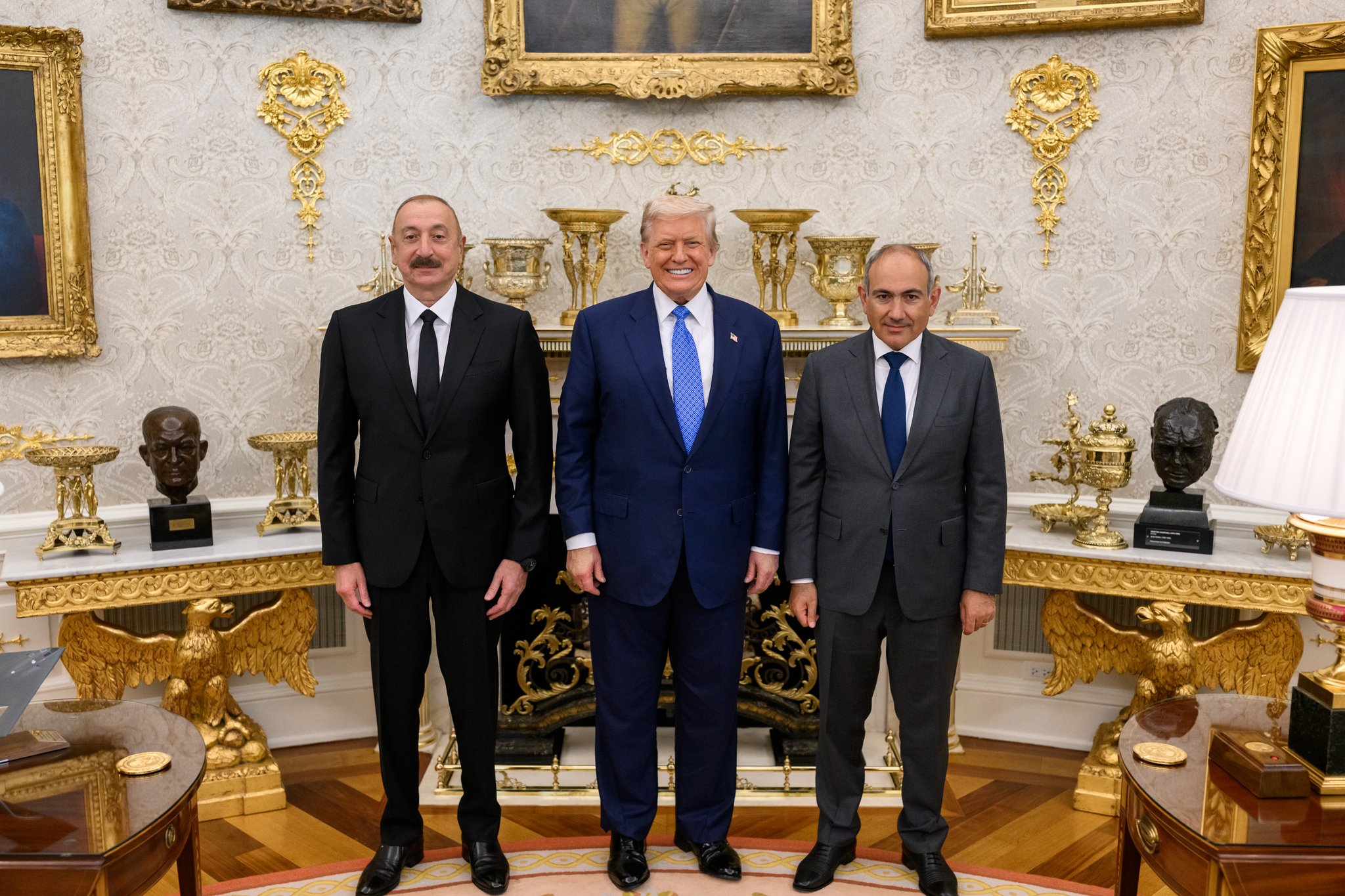
Aditi Bhaduri/New Delhi
On August 8, a trilateral summit between U.S. President Donald Trump, Armenian Prime Minister Nikol Pashinyan, and Azerbaijani President Ilham Aliyev took place at the White House, resulting in a historical joint declaration for peace between Armenia and Azerbaijan. The two South Caucasian neighbours had been locked in a bitter conflict for almost 35 years over the contested territory of Nagorno-Karabakh - an Armenian enclave within the territorial boundaries of sovereign Azerbaijan.
The leaders have pledged to continue working toward signing and ratifying the peace agreement and emphasized the importance of maintaining and strengthening peace.
Will the agreement bring genuine peace to the region and it's people? In Armenia, there has been some discontent with the declaration, as it did not address the concerns of the Armenians of Nagorno-Karabakh.
Along with the declaration for peace, an agreement for a crucial and strategic trade and transport corridor has also been signed between the two countries - Trump Route for International Peace and Prosperity” (TRIPP) connectivity project. This has called forth concern from Iran, which sees in the project and American encroachment in the region.
To understand the declaration and the fine print, Aditi Bhaduri spoke to Johnny G. Melikyan, a Senior Research Fellow at the Yerevan-based Orbeli Centre, a think tank connected to the Office of the Prime Minister of the Republic of Armenia.
1. Can you walk us through the agreements that Prime Minister Pashinyan and President Aliyev signed at the White House? I understand there were three of them?
The August 8th summit at the White House was highly symbolic. President Trump first met separately with Prime Minister Pashinyan and President Aliyev to sign bilateral Memoranda of Understanding with each side. These were declarative political documents, signaling intent rather than binding obligations.
Afterwards, the three leaders came together for a trilateral ceremony where they signed a Joint Declaration (Armenian-Azerbaijani), witnessed by the U.S. but concluded directly between Armenia and Azerbaijan. The text, released by both governments, consisted of seven key points:

US President Donald Trump with Armenian Prime Minister Nikol Pashinyan, and Azerbaijani President Ilham Aliyev at White House
i. The Armenian and Azerbaijani foreign ministers initialed a Peace and Interstate Relations Agreement – a preliminary step toward full signature and ratification.
ii. They jointly appealed to the OSCE to formally close the Minsk Process, launched back in 1992 to resolve the Karabakh conflict.
iii. Both sides reaffirmed the need to reopen regional communications, particularly a secure connection between Azerbaijan and its Nakhichevan exclave, based on respect for sovereignty and jurisdiction.
iv. Armenia agreed to cooperate with the U.S. and third countries to establish a new transit route across its territory – called the Trump Route for International Peace and Prosperity (TRIPP). Under the declaration, Armenia would transfer management of this route to the U.S. in an exclusive partnership for 99 years.
v. The leaders emphasized the principle of building relations free from past conflicts, explicitly referencing the UN Charter and the 1991 Alma-Ata Declaration on mutual recognition of post-Soviet borders.
vi. They expressed confidence that the Washington summit would provide a durable foundation for peace and mutual respect in the South Caucasus.
vii. Finally, both sides thanked President Trump for his hospitality and his “significant contribution” to normalizing Armenian-Azerbaijani relations.
It is worth stressing that this was not yet the final peace treaty.
Would any of these agreements need ratification by the Armenian parliament or change in the Armenian constitution?
At this stage, no. These are framework texts, expressing political intent and outlining future steps. They don’t have the legal status of an interstate treaty that requires ratification. But nothing signed in Washington immediately triggers parliamentary ratification or constitutional change.
We have been hearing some dissenting voices amongst Armenians bemoaning the fact that none of the agreements signed on Saturday dealt with the Armenians who were forced to leave Nagorno-Karabakh and their repatriation. How do you address this?
This is indeed one of the major shortcomings of the Washington package. There was no mention of the rights of Armenians forcibly displaced from Nagorno-Karabakh or of their possible return under international guarantees. There is, for instance, the unresolved issue of 23 Armenian POW's who still are being kept in Baku prison. And Donald Trump also mentioned this issue.
For many in Armenia, this is deeply problematic, because it signals that the issue of Karabakh Armenians is being gradually pushed off the international agenda. Unless international courts or separate UN-level processes address this, the question of repatriation will remain unresolved.
Armenia and Azerbaijan have resolved the conflict over the trade corridor connecting Baku with Nakhichevan. An American company is supposed to be developing the corridor as per the agreement. Who will finance the corridor? And will the American company have control over the entire corridor or only over the stretch running through Armenia? Is there any room for third party participation in the corridor, for instance, India?
We still do not know all the details. Maybe the financing is expected to come from a mix of sources – possibly with U.S. and EU support in the form of loans or grants for infrastructure development. The American company’s role is mainly technical and managerial; it will not “control” the corridor politically or militarily. Its mandate will cover construction and management of the Armenian stretch of the route.
There is potential for third-party involvement, for example India or other countries, within an international consortium framework. The key point emphasized by Yerevan is that this infrastructure must remain under Armenian sovereignty and function as part of a regional connectivity project, not as an extraterritorial zone.
Iran has come out strongly against the proposed corridor. Iran and Armenia have strong close ties. How will Armenia address Iran's concerns?
Iran’s reaction is driven by its fear that the Trump Route for International Peace and Prosperity (TRIPP) could undermine its geopolitical position and possibly bring NATO or U.S. presence closer to its borders. Yerevan is already in dialogue with Tehran, stressing that the TRIPP is strictly about infrastructure and economic connectivity.
Armenia emphasizes that it will remain under full Armenian jurisdiction and not turns into a geopolitical or military project. The government is also likely to propose that Iranian companies be invited to participate in certain elements of the infrastructure, to reassure Tehran that this is not directed against its interests.
ALSO READ: C Shukkur and Sheena set off a quiet 'remarriage' tsunami among Muslims
Iranian President Masoud Pezeshkian’s just-concluded visit to Armenia addressed Tehran’s concerns post-Washington summit and strengthened bilateral ties. Ten memorandums of understanding were signed, covering culture to politics. Both nations committed to elevating ties to a strategic level. Armenia clarified its stance on the U.S.-hosted trilateral summit, assuring Tehran it respects Iran’s “red lines” and will consider its position on regional routes, as stated by Iranian Foreign Minister Abbas.
The author is an independent journalist, who writes on the Central Asia and Middle East Affairs
